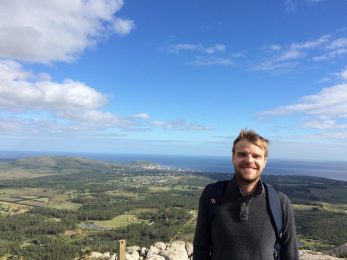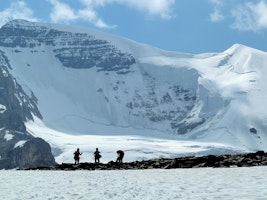Sitting just 15 kilometers (around 10 miles) away from the Alaskan border in Canada’s massive Yukon Territory (60°34′02″N 140°24′19″W), climbing Mount Logan should be on any dedicated mountaineers bucket list.
Rising to 5,959 meters (19,551 ft) in elevation, Mount Logan is the second highest peak in North America (just 181 meters/593 feet shorter than nearby Denali) and is widely considered to be among the most challenging mountaineering experiences in all of Canada!
While the climbing itself is not overly technical, Mount Logan’s sheer size is what makes it such a challenging ascent. The peak soars 3,000 meters (9,842 ft.) over all of its surroundings and completely fills the horizon, even from a great distance.
“[Mount Logan is in] one of the world’s most remote areas, which measures as the biggest massif by its base circumference,” Jeff Bullock, an ACMG-certified mountain guide who leads expeditions up to the top of the peak, tells Explore & Share.
Measuring at 20 kilometers in length and 5 kilometers wide, most guidebooks list Mount Logan as the “largest” mountain on Earth. To put its size in perspective, you could place Eiger, Mont Blanc and Mount Kilimanjaro on the summit plateau and still have a bit of space left over!
Needless to say, any expedition to the summit of Mount Logan requires quite a bit of planning and preparation. In order to determine whether this ascent is right for you, Jeff shared some advice and tips with us about how to prepare and what to expect!
What are the main Mount Logan climbing routes?
There are two main routes to reach the summit of Mount Logan: The Kings Trench and the East Ridge.
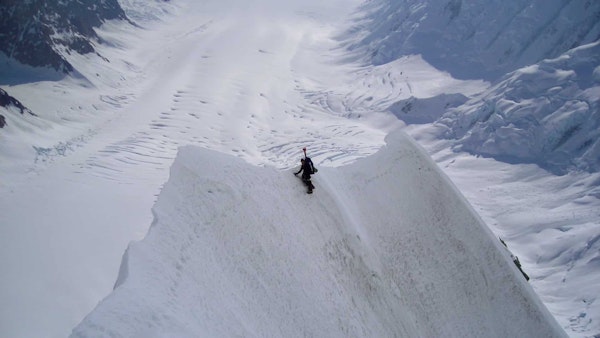
The east ridge of Mount Logan is considered the best high alpine wall climb in all of North America.(Photo by Christian Stangl (flickr))
The Kings Trench Route is the least technical one and mostly involves skiing up the large glacier system on the western side of the massif. Trips to this end of the mountain will begin with a flight onto the Quintino Sella Glacier.
The Kings Trench Route was taken by the first climbers known to have ascended Mount Logan in 1925.
Don’t hesitate a moment longer! Get ready for the adventure of a lifetime and book your next ascent of Mount Logan via the Kings Trench Route today!
Meanwhile, the East Ridge route is the top alpine climbing route up to the summit and includes the best high alpine wall climb in all of North America.
For 4,000 vertical meters, climbers follow a narrow and steep ridge line. While the climbing is never too technical, it is always interesting and certainly makes for quite the experience.
How long does it take to climb Mount Logan?
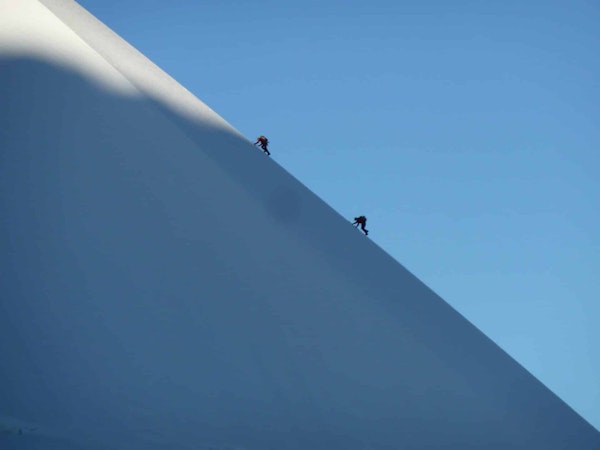
Photo by Jeff Bullock
Most expeditions to the top of Mount Logan will take about three weeks (excluding getting to and departing from Haines Junction). Due to the massive size of the mountain, quite a bit of time is spent on the approach from base camp to the start of the ascent.
The ascent itself only takes about a week as a slow acclimatization process is needed to successfully climb the peak.
Due to the abundance of rain in the summer and unpredictability of the weather, it is always best to have a few extra days built in. This ensures you have every opportunity possible to arrive at the summit on a clear day and enjoy the spectacular views.
How difficult is it to climb Logan? What kind of training do I need to do before climbing?
Reaching the summit of Mount Logan is difficult.
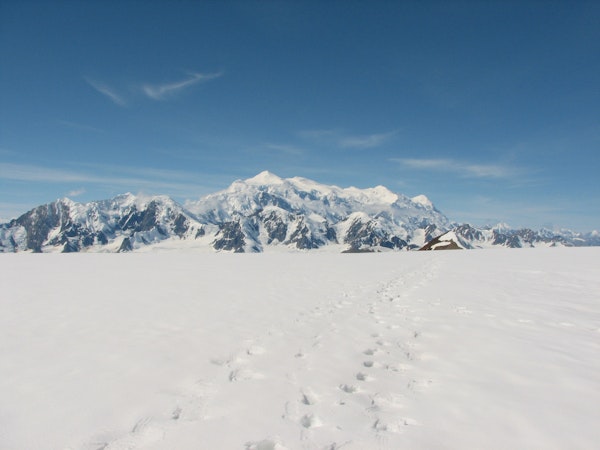
Mount Logan seen from the northeast. (Photo source: Wikipedia)
The mountain is huge, with roughly 5,250 meters(17,220 ft) of prominence. Along the way to the summit, you will need to climb, ski (or splitboard) and hike, all while carrying all of your own gear.
In order to succeed on this adventure of a lifetime, Jeff recommends that you have a combination of previous skiing and mountaineering experience as well as a high level of physical fitness.
“Previous ski touring or splitboarding experience is required which needs to be at a solid intermediate level,” he says. “Any previous climbing and/or mountaineering experience is an asset, including avalanche safety training and rope rescue skills.”
Preparing for the ascent of a lifetime up Mount Logan? Brush up on your splitboarding and mountaineering skills on Mount Whitehorn!
“High altitude experience is an asset as well,” Jeff adds. “Pre-trip training is mandatory and can be achieved by skiing and climbing as much as possible including carrying a heavy pack.”
Need to brush up on your avalanche safety skills? Check out Jeff’s 4-day Classic Wapta ski touring traverse!
Along with the physical preparation, it is also good to have some previous winter camping experience, as four of the camps you will be staying at are located above 4,000 meters (13,123 ft.) in elevation.
“It’s a big, cold and remote area with sometimes extreme weather and lots of glaciation,” Jeff says.
Equipment
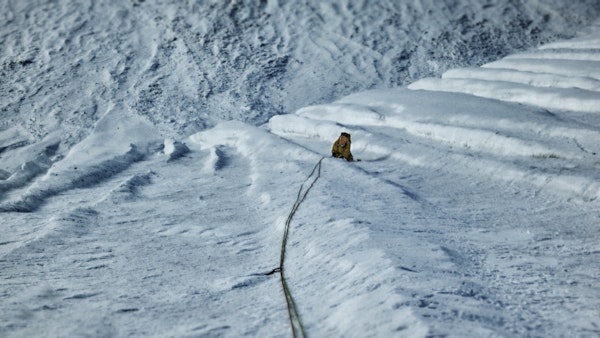
Photo by Jeff Bullock
Coming properly prepared to climb Mount Logan makes all the difference. In order to maximize your chances of successfully reaching the summit, Jeff recommends all climbers to bring the following:
Skis, recommended are shorter (160 – 185cm) mid-fat to fat ski designed for powder and spring snow conditions. Dynafit tech bindings are preferred
Climbing skins
Ski Poles/ split boarders too
Ski boots/ snowboard boots
Gaiters insulated needs to fit with ski bindings consider 40 below brand over boots
Ski crampons
Strap on boot crampons
Avalanche beacon with fresh batteries
Snow shovel
Avalanche probe
Daypack, 35-45 L
Expedition pack 65-75L
Sunglasses, real glacier glasses with side shields
Ski goggles
Thermos flask 1 liter
2x 1 liter water bottle with insulated holder
pee bottle (well marked)
Sun block & Lip Cream
Pocket knife or Leatherman style tool
Eating utensils
Bowl & plate
Camp mug
Headlamp with fresh batteries
small Blister & personal 1st-Aid Kit
-30 deg down sleeping bag
Insulated therma-rest
Insulate pad
Camp pillow
Camp chair, small & packable
Camera (s)
Toiletries: toothbrush/paste, sleep mask, wet wipes
Heat pads for colder moments
Lightweight climbing harness for glacier travel
3x locking carabiners, 2 non-locking carabiners
2x 4-6 m long 6mm cord, 1 sewn sling
2x ice screws
Standard lightweight ski mountaineering axe 50-70 cm
1-2 Large duffle bags
Weather and Best season
The best time to climb Mount Logan is from May to August, as these months offer the best climbing conditions.
At the base of the mountain, average temperatures will be a bit less than 20 ºC (68ºF). These decrease as you climb in elevation and by the time you’ve reached 5,000 meters (16,404 ft.) will be well below freezing.
Summer is also the wettest time of year in the Elias Mountains. However, May is substantially drier than any of June, July or August.
The weather on Mount Logan can be quite volatile, with storms setting in quickly. Depending on the weather, not every expedition to the top may be successful and some may not be able to happen at all. For this reason, Jeff highly recommends the purchase of trip cancellation insurance.
How to get to Mount Logan
Due to its remote location within Kluane National Park Reserve, Mount Logan is fairly difficult to reach.
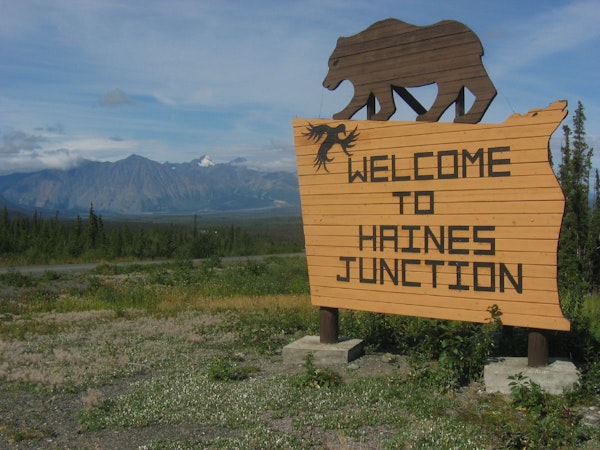
Any trip to the summit of Mount Logan begins with a chartered flight into the remote outpost of Haines Junction. (Photo by John Johnstone (Flickr))
Any adventure to the peak begins with a flight into Haines Junction Airport (YHT), which can be reached by a charter flight from nearby Erik Nielsen Whitehorse International Airport (YXY).
Haines Junction is where you will meet your guide. From here, there will be another flight closer to Mount Logan (exactly where depends on your route of ascent).
No roads lead anywhere near the mountain.
How much does it cost to climb Mount Logan?
For his 20-day expedition to the summit of Mount Logan, Jeff charges CAD$7,700 per person.
This price includes his fee for the guiding service, all permits and entrance fees, the flight from Haines Junction to Mount Logan base camp, all meals during the trip and all climbing and camping equipment.
Other guides generally offer similar packages at similar prices.
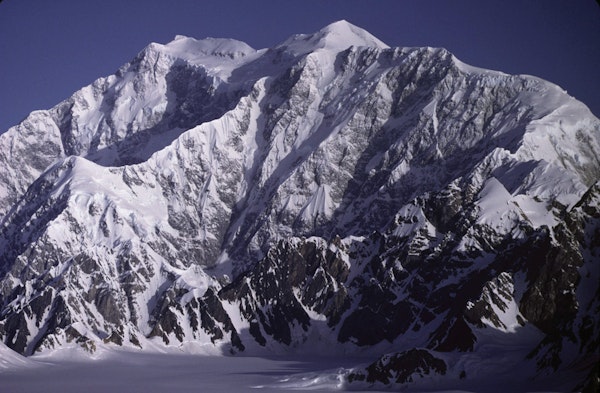
While not technically difficult, climbing Mount Logan is best done with an experienced and certified guide, who can manage the logistics and get you to the summit. (Photo by Gerald Holdsworth, National Oceanic and Atmospheric Administration).
It’s never too early to begin planning your next incredible summertime adventure. If it’s right for you, climbing Mount Logan offers plenty of incredible scenery, excellent climbing and the opportunity for some summertime skiing as well! See you at the top!

